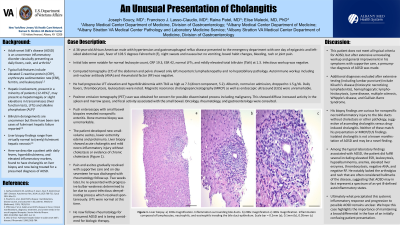Tuesday Poster Session
Category: Liver
P3870 - An Unusual Presentation of Cholangitis
Tuesday, October 24, 2023
10:30 AM - 4:00 PM PT
Location: Exhibit Hall

Has Audio

Joseph Soucy, MD
Albany Medical Center
Albany, NY
Presenting Author(s)
Joseph Soucy, MD1, Francisco J. Lasso Claudio, MD1, Raina Patel, MD2, Elise Malecki, MD, PhD2
1Albany Medical Center, Albany, NY; 2Albany Stratton VA Medical Center, Albany, NY
Introduction: Maintaining a broad differential is of paramount importance if a unifying diagnosis is not immediately evident. Even familiar diseases can flummox the unprepared physician if unexpected in their presentation. Here we describe a patient with daily fevers, hyperbilirubinemia, and elevated inflammatory markers with otherwise negative workup, found to have liver biopsy findings consistent with acute cholangitis.
Case Description/Methods: A 36 year-old African American male presented to the emergency department with epigastric abdominal pain and daily fevers. He also had night sweats and nausea but no vomiting, bowel habit changes, bleeding, rash or joint pain.
Labs revealed elevated bilirubin, C-reactive protein and erythrocyte sedimentation rate with normal leukocyte count. Computed tomography of the abdomen and pelvis with intravenous contrast showed left mesenteric lymphadenopathy but no other abnormalities; no hepatic or biliary pathology was noted. Infectious workup was unrevealing. He had progressive hyperbilirubinemia but subsequent magnetic resonance cholangiopancreatography (MRCP) and endoscopic ultrasound (EUS) were unremarkable.
Liver biopsy showed acute cholangitis and mild necroinflammatory injury without cholestasis. With supportive care his pain improved though he continued to have fever and hyperbilirubinemia. He was discharged with outpatient follow-up. Subsequent notes indicate that he is now being treated by rheumatology for a presumed diagnosis of adult-onset Still’s disease (AOSD).
Discussion: AOSD classically presents as daily fevers, rash, and arthritis with elevations in inflammatory markers. Hepatic involvement may manifest as slight elevation in transaminases, but isolated cholangitis is not a known presentation of the disease. This patient’s liver biopsy findings are curious for nonspecific inflammatory injury to the bile ducts without cholestasis or other pathology. This is suggestive of acute ascending cholangitis versus drug-induced cholangitis, neither of which matched his presentation or his MRCP/EUS findings.
Though the patient notably lacked the arthralgias and rash that are often hallmarks of AOSD, his overall clinical picture and laboratory findings were felt to be consistent with an as-yet unidentified trigger resulting in a systemic inflammatory response and likely eventual progression to overt AOSD for which he is now being treated. We hope this case highlights the importance of keeping an open mind in the face of a confusing initial patient presentation.
Disclosures:
Joseph Soucy, MD1, Francisco J. Lasso Claudio, MD1, Raina Patel, MD2, Elise Malecki, MD, PhD2. P3870 - An Unusual Presentation of Cholangitis, ACG 2023 Annual Scientific Meeting Abstracts. Vancouver, BC, Canada: American College of Gastroenterology.
1Albany Medical Center, Albany, NY; 2Albany Stratton VA Medical Center, Albany, NY
Introduction: Maintaining a broad differential is of paramount importance if a unifying diagnosis is not immediately evident. Even familiar diseases can flummox the unprepared physician if unexpected in their presentation. Here we describe a patient with daily fevers, hyperbilirubinemia, and elevated inflammatory markers with otherwise negative workup, found to have liver biopsy findings consistent with acute cholangitis.
Case Description/Methods: A 36 year-old African American male presented to the emergency department with epigastric abdominal pain and daily fevers. He also had night sweats and nausea but no vomiting, bowel habit changes, bleeding, rash or joint pain.
Labs revealed elevated bilirubin, C-reactive protein and erythrocyte sedimentation rate with normal leukocyte count. Computed tomography of the abdomen and pelvis with intravenous contrast showed left mesenteric lymphadenopathy but no other abnormalities; no hepatic or biliary pathology was noted. Infectious workup was unrevealing. He had progressive hyperbilirubinemia but subsequent magnetic resonance cholangiopancreatography (MRCP) and endoscopic ultrasound (EUS) were unremarkable.
Liver biopsy showed acute cholangitis and mild necroinflammatory injury without cholestasis. With supportive care his pain improved though he continued to have fever and hyperbilirubinemia. He was discharged with outpatient follow-up. Subsequent notes indicate that he is now being treated by rheumatology for a presumed diagnosis of adult-onset Still’s disease (AOSD).
Discussion: AOSD classically presents as daily fevers, rash, and arthritis with elevations in inflammatory markers. Hepatic involvement may manifest as slight elevation in transaminases, but isolated cholangitis is not a known presentation of the disease. This patient’s liver biopsy findings are curious for nonspecific inflammatory injury to the bile ducts without cholestasis or other pathology. This is suggestive of acute ascending cholangitis versus drug-induced cholangitis, neither of which matched his presentation or his MRCP/EUS findings.
Though the patient notably lacked the arthralgias and rash that are often hallmarks of AOSD, his overall clinical picture and laboratory findings were felt to be consistent with an as-yet unidentified trigger resulting in a systemic inflammatory response and likely eventual progression to overt AOSD for which he is now being treated. We hope this case highlights the importance of keeping an open mind in the face of a confusing initial patient presentation.
Disclosures:
Joseph Soucy indicated no relevant financial relationships.
Francisco Lasso Claudio indicated no relevant financial relationships.
Raina Patel indicated no relevant financial relationships.
Elise Malecki indicated no relevant financial relationships.
Joseph Soucy, MD1, Francisco J. Lasso Claudio, MD1, Raina Patel, MD2, Elise Malecki, MD, PhD2. P3870 - An Unusual Presentation of Cholangitis, ACG 2023 Annual Scientific Meeting Abstracts. Vancouver, BC, Canada: American College of Gastroenterology.
